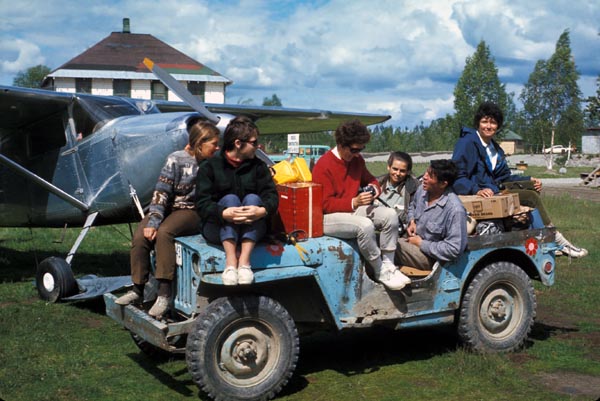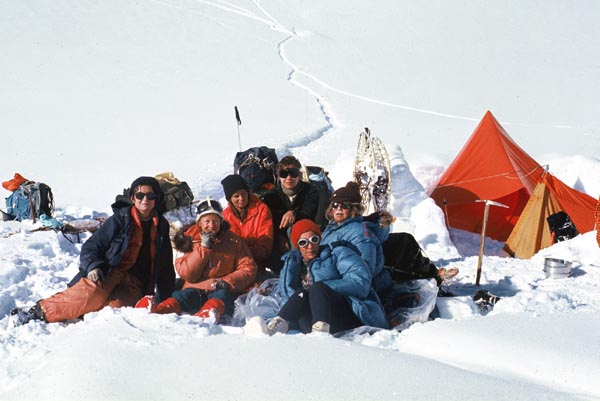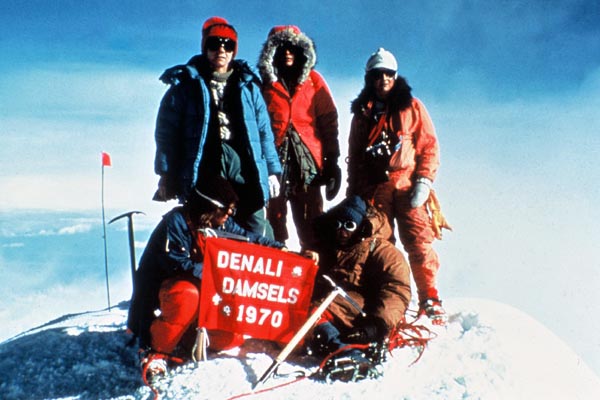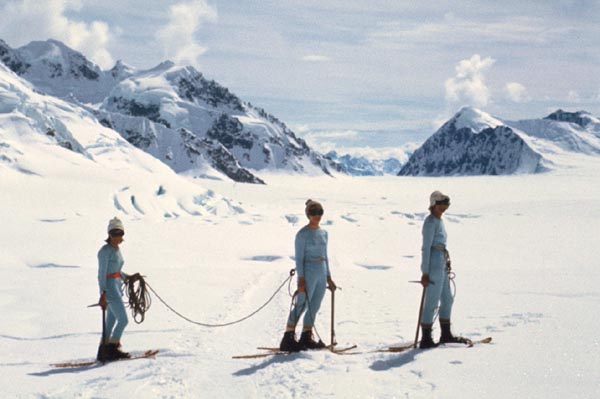 (Photo courtesy of Arlene Blum)
(Photo courtesy of Arlene Blum)Denali is no different, and some of the early expeditions are fairly well known among mountaineers and even outside of the climbing community. The Sourdough Expedition of 1910 for example, was perhaps the first Alaskan expedition to gain attention outside of their team, with people in Fairbanks rooting for the miners to reach the summit and thereby prove the toughness of Alaskans. The West Buttress route, by far the most common route to Denali’s summit, was first climbed by Bradford Washburn in 1951. Washburn, a person of vision, helped open the modern era on Denali, as climbing the Buttress from Kahiltna base camp avoids the 20-mile tundra walk from Wonder Lake to the Muldrow Glacier on the north side of the mountain.
Many people also know that on June 6, 1947, Barbara Washburn made history when she became the first woman to reach the 20,310-foot summit of Denali. The next day, Barbara stood atop Denali’s north summit, showing her strength and character to get up after summit day for another challenging climb. Washburn, when asked about the climb, said humbly, that any woman could climb the mountain if they had “the desire to be uncomfortable.”
What many people might not realize, is that 2020 marks the 50 year anniversary of a lesser known milestone for the highest peak on the continent. In 1970, Grace Hoeman led the first all-female team to the summit of Denali. In addition to Hoeman, the team consisted of Arlene Blum, Margaret Clark, Faye Kerr, Dana Isherwood, and Margaret Young. The Denali Damsels, as they called themselves, climbed to the summit and then managed an impressive self-rescue from the upper mountain when Hoeman became incapacitated due to altitude.
 The Denali Damsels and their gear get shuttled to Talkeetna's Village Airstrip by bush pilot Don Sheldon. (Photo courtesy of Arlene Blum)
The Denali Damsels and their gear get shuttled to Talkeetna's Village Airstrip by bush pilot Don Sheldon. (Photo courtesy of Arlene Blum)When Grace Hoeman collapsed around 19,500’, Arlene Blum stepped into the leader role to save their teammate’s life. Bundling Hoeman in a cocoon of sleeping bags, the women dragged the unconscious Hoeman down until they were forced to spend an unplanned night above Denali Pass. Through hard work and persistence, the team was able to get Hoeman back to their snow cave at 17,300’. During the descent, between 17,300’ and 14,200’, Hoeman recovered enough to regain her role as leader of the expedition for the remaining descent. The team completed the descent in style and without further mishaps, all while singing at the top of their lungs according to Blum’s account.
 The Damsels at their 'Camp Three' on Denali (Photo courtesy of Arlene Blum)
The Damsels at their 'Camp Three' on Denali (Photo courtesy of Arlene Blum)To put this climb in perspective, we can look at other events of the times. When the Denali Damsels stood atop the highest point of North America, no woman had climbed El Cap. The Damsels were a full three years ahead of Bev Johnson climbing El Cap with Dan Asay in June of 1973. Johnson and Sibylle Hechtel became the first all-women’s team to climb El Cap 3 months later in September of 1973. Japan’s Junko Tabei wouldn’t become the first woman to summit Everest until 1975. Arlene Blum would make history again in 1978 by leading an all-female climb of Annapurna, an expedition that put the first American, male or female, on the summit. To raise money for the trip, the team sold t-shirts that read “A woman’s place is on top.”
While Barbara Washburn had set the bar by standing on the summit, the Denali Damsels planned and executed the entire expedition, thus raising the bar for the next generations. Not only that, the Denali Damsels performed a heroic self-rescue that goes beyond what most people would be capable of. This monumental climb, when looked at from the perspective of 50 years later, opened the door for others to see past what had already been set as the norm. Expeditions such as Karen McNeill and Sue Nott’s 2004 Cassin Ridge climb, Chantel Astorga and Jewell Lund’s Denali Diamond ascent in 2015, Katie Bono’s solo speed ascent in 2017, and Astorga’s ascent of the Slovak Route with Anne Gilbert Chase in 2018, to name just a few, were directly or indirectly influenced by Barbara Washburn and the Denali Damsels.
 The Denali Damsels on the summit of North America's highest peak, an historic first for the all-female climbing team. (Photo courtesy of Arlene Blum)
The Denali Damsels on the summit of North America's highest peak, an historic first for the all-female climbing team. (Photo courtesy of Arlene Blum)In addition to personal expeditions that the Damsels influenced, this year marks a change in the Denali team, as we have added 3 women to the 11-person mountaineering staff. While it would be easy to see this as mere coincidence, I recently chatted with Denali Rescue Volunteer and first year ranger Kailyn McGrath about the Denali Damsels expedition. McGrath immediately pointed to Arlene Blum as one of her earliest role models in the mountaineering world. “When I was 20, I was a rock climber and I was looking to get into mountaineering. I got tired of reading mountaineering books by male authors, and then I found Arlene Blum’s book. I was inspired by her story.” Kailyn has gone on to work and play in mountains around the world, and in turn inspires the people around her. One of those climbers is another new staff member, Chrissie Oken. Chrissie was a participant on a mountaineering seminar that McGrath led in the Chugach Range, and has since gone on to lead successful expeditions on Denali’s Muldrow Glacier Route as well as Canada’s Mt. Logan, to name just a few. I speak for myself and for the rest of the team when I say I feel fortunate to work with such talented mountaineers.
Every year climbers are re-establishing the limits of what is possible on Denali. With each step forward, it appears that our imagination is the only thing holding us back. So as we watch the bar get raised higher each season, let us not forget who set the bar higher at each step along the way. Cheers to the Denali Damsels for ignoring societal norms of the 1970’s, planning and executing a climb in good style, and singing as a team as they descended!
 Three of the teammates strip down to their Duofolds during the heat of the day. (Photo courtesy of Arlene Blum)
Three of the teammates strip down to their Duofolds during the heat of the day. (Photo courtesy of Arlene Blum)For more information about Arlene Blum and other great photos from the Denali Damsels historic climb of the West Buttress, go to Arlene's website.
